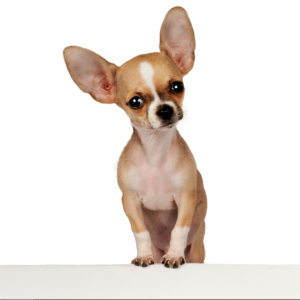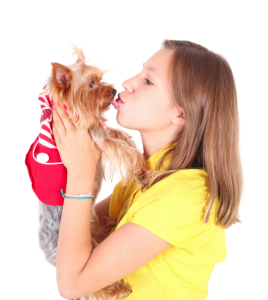 From Rin tin tin to Lassie, Benjie and Beethoven, medium to large dogs have dominated the Hollywood scenes, the TV shows as well as our homes. Often statements of prosperity, leadership and strength, dogs convey a certain image we have of ourselves. Just like a fancy car or nice piece of clothing, we own the type dog that we feel proud of. For many, no matter how friendly, a large dog helps us feel safe, strong and confident. In the past years however, large breed dogs have seen a shift in their popularity. Motivated by economics or fashion, many households now favor the smaller breeds. Today, 48% of dogs weigh under 25 lbs. Small dogs cost less to feed, shed less, live longer, are easier to manage, require less time to walk and produce less waste. They’re cute, cuddly, fit in a purse and are fun to carry around. Despite their cute features and baby like faces, smaller dogs are also considered yappy, snappy and barky. But are they truly ankle biters and over protective troublemakers or is this mostly an unjustified reputation? Research shows that these miniature pooches may indeed come with a drawback: smaller breeds tend to have more behavior problems.
From Rin tin tin to Lassie, Benjie and Beethoven, medium to large dogs have dominated the Hollywood scenes, the TV shows as well as our homes. Often statements of prosperity, leadership and strength, dogs convey a certain image we have of ourselves. Just like a fancy car or nice piece of clothing, we own the type dog that we feel proud of. For many, no matter how friendly, a large dog helps us feel safe, strong and confident. In the past years however, large breed dogs have seen a shift in their popularity. Motivated by economics or fashion, many households now favor the smaller breeds. Today, 48% of dogs weigh under 25 lbs. Small dogs cost less to feed, shed less, live longer, are easier to manage, require less time to walk and produce less waste. They’re cute, cuddly, fit in a purse and are fun to carry around. Despite their cute features and baby like faces, smaller dogs are also considered yappy, snappy and barky. But are they truly ankle biters and over protective troublemakers or is this mostly an unjustified reputation? Research shows that these miniature pooches may indeed come with a drawback: smaller breeds tend to have more behavior problems.
German shepherds, Boxers, Labrador and golden retrievers still figure amongst the top 10 breeds on the American Kennel Club list, but beagles, poodles, Shih Tzus, bulldogs, Yorkshire terriers and Dachsunds have gained in popularity in the past 10 years. An aging population, combined with tough economic times and an increase in urban and apartment lifestyle, have drawn dog lovers of all sorts to pay more attention to the smaller and more practical pooches. This swing in the dog owners’ choices has already affected the food and veterinary industry since smaller breeds eat less and develop different health issues than the larger ones. But how does a Chihuahua compare to a Great Dane or a Rottweiler on the behavior scale? Are we really just downsizing, or does this new trend in size also require a shift in our expectations with a multiplication of behavior problems?
 Several studies have shown that since the shape of the dogs skull directly affects the shape of the brain, the morphology of a dog’s head changes the way that the dogs perceive external stimuli and possibly also, how they process information (Coppinger & Scheider, 1995). Shorter-skulled dogs have more visual acuity in the center of their visual field for instance, where dogs with longer noses will be better at detecting movement with their peripheral vision, but will also be more likely to follow human pointing gestures. It makes sense then to see how such physical differences may also affect the dogs’ inherent behaviors.
Several studies have shown that since the shape of the dogs skull directly affects the shape of the brain, the morphology of a dog’s head changes the way that the dogs perceive external stimuli and possibly also, how they process information (Coppinger & Scheider, 1995). Shorter-skulled dogs have more visual acuity in the center of their visual field for instance, where dogs with longer noses will be better at detecting movement with their peripheral vision, but will also be more likely to follow human pointing gestures. It makes sense then to see how such physical differences may also affect the dogs’ inherent behaviors.
A new study, from the University of Sydney, focused on identifying if there is a link between the height, the bodyweight, the skull shape and the dogs behavior profile ( McGreevy & al., 2013). Surveying over 8000 dog owners, using the Canine Behavioral Assessment and Research Questionnaire (C-BARQ), the research team gathered an extensive database that allowed them to compare dogs based on their morphology and behavior. Out of the 36 behaviors deemed problematic, 33 were correlated with the dogs’ height, weight and skull shape. What came out of this study is that, height alone, is a strong predictor of certain behavior traits. Smaller dogs tend to mount people or objects more often than their counterparts. They’re more sensitive to touch, they have a higher tendency to eliminate in the house when left alone, have more separation anxiety, more fear, excitability and hyperactivity and a higher rate of owner directed aggression. They beg for food, urine mark and seek attention. In short, the smaller the dog, the more problematic the behavior!
So now that we’ve confirmed that, micro dogs do indeed live up to their reputation, what does this all mean? If there is a correlation between size and certain behavior problems, we still don’t know if this difference is due to genetics, to inherited traits or to the way that we treat our miniature friends. It’s possible that in the process of breeding for smaller size, we also increased the incidence of such behaviors through genetics. It is also likely that many of the described problems are in part, due to overprotective and overindulgent treatment. A Yorkie jumping to great us, really isn’t the same as a Dalmatian or Newfoundland. Why not snuggle up with Bitsy or Bonsai, carry her around most of the time, just lift her up when there’s another dog or person in sight and shrug at the small occasional messes left in the house? It’s easy and requires very little effort on our part.
 Whether nature or nurture (or a little of both), from the dog’s perspective, the picture isn’t quite as rosy as it is to the human. Elimination when left alone, separation anxiety, touch sensitivity, hyperactivity, reactivity and general fears are all signs that the dogs are subject to regular, if not ongoing stress. Pint-size pooches are treated with much love and affection, but unfortunately, they’re not taught basic coping skills that larger dogs generally acquire naturally through their exposure to the world. When a dog is constantly touched, carried and loved on while we’re around, how will he feel once alone?
Whether nature or nurture (or a little of both), from the dog’s perspective, the picture isn’t quite as rosy as it is to the human. Elimination when left alone, separation anxiety, touch sensitivity, hyperactivity, reactivity and general fears are all signs that the dogs are subject to regular, if not ongoing stress. Pint-size pooches are treated with much love and affection, but unfortunately, they’re not taught basic coping skills that larger dogs generally acquire naturally through their exposure to the world. When a dog is constantly touched, carried and loved on while we’re around, how will he feel once alone?
For the dog’s sake, it is our responsibility to help our companions, regardless of their height, develop confidence and move around the world with curiosity and purpose instead of stress and anxiety. Small dogs, just like any other dog, deserve the right to be educated and properly socialized. We often consider that those behaviors just come with owning such a dog and don’t even consider that it can be different. If these behaviors happen to develop through unfortunate breeding, our effort in providing them with nurturing conditions increases even more. Loving another being is about caring about their needs and doing what we can to make their lives easier and more agreeable. Let’s wake up to the fact that, what this study really reveals, is that, for the love of our pocket-size pooches, their advantages in height does not also downsize our moral commitment to them and our obligation to teach them how to be social and happy pets.
For tips to help your dog develop confidence, please visit: ‘10 effective ways to help our dogs feel safe‘.
Jennifer Cattet Ph.D.


Speaking as someone who has owned dogs of assorted sizes, I would say that any difference in behaviour is likely to be because of human selection. Behaviour that would get a large breed destroyed is often not seen as a problem with small dogs. The “Oh, ho ho, isn’t she cute/brave thinking she can take on that dog whose head is as large as she is!” versus “Your Big Dog is a danger to public because she growled at my little dog, She should be destriyed.” And frequently the law up-holds this bias. Ad I DO know that a German Shepherd that attacks the postman is more likely to kill the postie than is a Chihuahua that attacks him.
So these behavioural characteristic are perpetuated in the small breeds and eliminated in the large breeds. (And of course the medium breeds are somewhere in between 🙂
I see lots of little dogs who are never taught manners by their guardians. Personally, I am a fan of the big dogs anyway. lol
I, personally, agree with Cesar Millan that a dog’s behavior “issues” are usually a mirror of its human’s behavior. And, if the human spoils his/her dog, the dog is going to act spoiled. It is not cute, any more than a toddler throwing a temper tantrum is cute. A dog is not born “spoiled”, or even made spoiled by its biological mother, it is made to act spoiled by its human’s misguided ideas.
This is all very interesting; anecdotally, I feel like I see more small dogs with behavioral issues than large dogs. I agree with Linda; I think it has less to do with the size and more to do with the fact that the small size leads humans to believe that dogs don’t need to be trained or helped with their issues. Behavioral problems in small dogs often get written off as “cute,” whereas in a lab or a German shepherd, the same problem would receive the label “downright dangerous.”
It’s hard that large dogs often get a bad rep for growling and other potentially dangerous behavior when small dogs can act the same way, but not be so worrisome simply because of their size. It’s not fair to either dog type, and while large dogs would do much more damage than a small dog, the behavior is still something that must be corrected!
Bitting issues in sm dogs
My dog is 4yrs old going thur medical promblms she bites me
You might find a few useful tips in the following post: http://blog.smartanimaltraining.com/2013/06/13/preparing-your-dog-for-the-vet/
Our small dog was very well trained and well behaved. Until she had an accident at 11 years of age. Now she has behavior problems when her medication isn’t given on time. Sometimes life happens and you get a call saying your daughter was in a car accident a couple hours before medication time and you get home after midnight to a dog who is misbehaving due to a missed dose. Training no matter how good it is can be forgotten when circumstances make instinct take over.